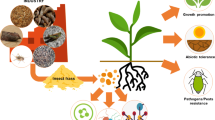Abstract
The zoophytophagous predator Dicyphustamaninii Wagner (Heteroptera: Miridae) hasbeen successfully reared for more than fivegenerations on a meat-based diet, and in theabsence of a plant as a substrate foroviposition and feeding. We compared thepredation efficiency of D. tamaniniiproduced on this diet with those rearedconventionally on Ephestia kuehniellaeggs (Zeller) (Lepidoptera: Pyralidae) andtobacco plants. Their performances wereevaluated on two prey, the greenhouse whiteflyTrialeurodes vaporariorum Westwood(Homoptera: Aleyrodidae) and the cotton aphidAphis gossypii Glover (Homoptera: Aphididae). Their tendency to cannibalisticbehaviour was also evaluated.Nymphs of D. tamaninii produced on themeat diet consumed a similar number ofgreenhouse whitefly pupae after 24 and 48 hoursto nymphs reared by the conventional method.Diet-reared females consumed significantly morewhitefly pupae after 24 and 48 hours thancontrol females. When the cotton aphid wasoffered, diet-reared D. tamaninii nymphsand females consumed similar numbers of prey tocontrol D. tamaninii. There was nosignificant increase in cannibalistic behaviourof diet-reared D. tamaninii after 3 and 5days of interaction.These results show that, after fivegenerations, the predation efficiency and thetendency to cannibalism of meat-reared D.tamaninii is similar to that ofconventionally-reared individuals.
Similar content being viewed by others
References
Agustí, N., 1998. Biología de Dicyphus tamaninii Wagner (Heteroptera: Miridae) i identificació molecular de les preses ingerides. Ph.D. Thesis, Departament de Biologia Animal (Artròpodes), Facultat de Biologia, Universitat de Barcelona. p. 184.
Albajes, R., O. Alomar, J. Riudavets, C. Castañé, J. Arnó and R. Gabarra, 1996. The mirid bug Dicyphus tamaninii: an effective predator for vegetable crops. IOBC/WPRS Bull. 19: 1–4.
Alomar, O. and R. Albajes, 1996. Greenhouse whitefly (Homoptera: Aleyrodidae) predation and tomato fruit injury by the zoophytophagous predator Dicyphus tamaninii (Heteroptera: Miridae). In: O. Alomar and R.N. Wiedenmann (eds), Zoophytophagous Heteroptera: Implications for Life History and Integrated Pest Management. Entomological Society of America, Lanham, MD. pp. 155–177.
Alvarado, P., O. Baltà and O. Alomar, 1997. Efficiency of four Heteroptera as predators of Aphis gossypii and Macrosiphum euphorbiae (Hom.: Aphididae). Entomophaga 42: 215–226.
Chocorosqui, V.R. and P. De Clercq, 1999. Developmental and predatory performance of Podisus maculiventris (Say) (Heteroptera: Pentatomidae) reared on a meat-based artificial diet. Med. Fac. Landbouw. Univ. Gent. 64: 229–234.
Castañé, C., O. Alomar, M. Goula and R. Gabarra, 2000a. Natural populations of Macrolophus caliginosus and Dicyphus tamaninii in the control of the greenhouse whitefly in tomato crops. IOBC/WPRS Bull. 23: 221–224.
Castañé, C., O. Alomar and J. Riudavets, 2000b. Dicyphus tamaninii in the biological control of cucumber pests. IOBC/WPRS Bull. 23: 253–256.
Cohen, A.C., 1985. Simple method for rearing the insect predator Geocoris punctipes (Heteroptera: Lygaeidae) on a meat diet. J. Econ. Entomol. 78: 1173–1175.
Cohen, A.C. and L.K. Smith, 1998. A new concept in artificial diets for Chrysoperla rufilabris: the efficacy of solid diets. Biol. Control 13: 49–54.
Cohen, A.C., 2000. Feeding fitness and quality of domesticated and feral predators: effects of long-term rearing on artificial diet. Biol. Control 17: 50–54.
Constant, B., S. Grenier and G. Bonnot, 1996. Artificial substrate for egg laying and embryonic development by the predatory bug Macrolophus caliginosus (Heteroptera: Miridae). Biol. Control 7: 140–147.
De Clercq, P., F. Merlevede and L. Tirry, 1998. Unnatural prey and artificial diets for rearing Podisus maculiventris (Het.: Pentatomidae). Biol. Control 12: 137–142.
De Clercq, P. and D. Degheele, 1993. Quality of predatory bugs of the genus Podisus reared on natural and artificial diets. In: G. Nicoli and M. Benuzzi (eds), “Quality Control of Mass Reared Arthropods”, September 25–28, 1993, Rimini, Italy. pp. 129–143.
Fox, L.R., 1975. Cannibalism in natural populations. Annu. Rev. Ecol. Syst. 6: 293–302.
Hagler, J.R. and A.C. Cohen, 1991. Prey selection by in vitro and field-reared Geocoris punctipes. Entomol. Exp. Appl. 59: 201–205.
Iriarte, J. and C. Castañé, 2001. Artificial rearing of Dicyphus tamaninii (Heteroptera: Miridae) on a meat-based diet. Biol. Control 22: 98–102.
Joyner, K. and F. Gould, 1987. Conspecific tissues and secretions as sources of nutrition. In: F.J. Slansky and J.G. Rodriguez (eds), Nutritional Ecology of Insects, Mites, Spiders, and Related Invertebrates. John Wiley & Sons, New York. pp. 837–884.
Lucas, E. and O. Alomar, 2001. M. caliginosus (Wagner) as an intraguild prey for the zoophytophagous Dicyphus tamaninii Wagner (Heteroptera: Miridae). Biol. Control 20: 147–152.
Montserrat, M., R. Albajes and C. Castañé, 2000a. Comparative behaviour of three predators used in biological control in greenhouse crops. IOBC/WPRS Bull. 23: 267–272.
Montserrat, M., R. Albajes and C. Castañé, 2000b. Functional response of four Heteropteran predators preying on greenhouse whitefly (Homoptera: Aleyrodidae) and western flower thrips (Thysanoptera: Thripidae). Environ. Entomol. 29(5): 1075–1082.
Polis, G.A., 1981. The evolution and dynamics of intraspecific predation. Annu. Rev. Ecol. Syst. 12: 225–251.
Saavedra, J.L.D., J.C. Zanuncio, T.V. Zanuncio and R.N.C. Guedes, 1997. Prey capture ability of Podisus nigrispinus (Dallas) (Het. Pentatomidae) reared for successive generations on a meridic diet. J. Appl. Entomol. 121: 327–330.
Author information
Authors and Affiliations
Rights and permissions
About this article
Cite this article
Castañé, C., Iriarte, J. & Lucas, E. Comparison of prey consumption by Dicyphus tamaninii reared conventionally, and on a meat-based diet. BioControl 47, 657–666 (2002). https://doi.org/10.1023/A:1020551100273
Issue Date:
DOI: https://doi.org/10.1023/A:1020551100273




